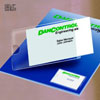Shopping Cart [more]
Index of Products
- Laminator Replacement Parts
- School Laminators
- Laminators by Manufacturer->
- Pouch Laminators / Pouches
- Laminating Films
- Nap I and Nap II Films, GBC Laminating Films
- DigiSeal Laminating Film
- Opti Clear Laminating Film
- Tamerica Laminating Films
- Durafilm Laminating Film
- Cutters and Trimmers
- Dry Mount Tissues, Foam Board/Presses
- Expression Mechanical Presses
- Foam Board
- Olfa Products
- Pressure Sensitive Products
- Roller Cleaning
Information
When Buying A Laminator
Selecting The Right Laminator
It's wise to be discriminating when
buying equipment for laminating
by Dan Evans

GWJ Co believes customers should make decisions based on information and facts. We present this article to make buying the right laminator a little easier.

If you're thinking about buying an inkjet or electrostatic printer, you're probably going to hear a lot about laminating and mounting. Because for many applications of these types of printers, laminating is not an option, its a requirement. If you already own an inkjet or electrostatic printer, you've already confronted the issues of laminating and mounting, but perhaps have discovered that the equipment you bought doesn't meet all your needs.
Much of what you hear about laminating may be contradictory and confusing. So let's arm you with some facts. To help you select the right laminator for your digital graphics, here are some questions to consider.

Why laminate?
First of all, why laminate any printed material? And why laminate big-format color? Lamination protects, preserves and enhances printed images. It deepens and brightens colors, enhances contrasts, waterproofs, and protects from smudges, spills, abrasions and other routine hazards. If the print will be exposed to sunlight, laminates can slow down the fading process
Some conventionally printed graphics have been laminated since the development of the laminating process about 40 years ago, even though the cost of lamination is often as much or more than the cost of printing. For example, a typical 8.5 x 11-in color product sheet might cost about 10 cents each to print in large quantities. Laminating it with a good quality 3-mil film will usually cost a little more than that.

Typically laminated items include menus, instructional materials, posters and promotional materials. Lamination allows these paper graphics to look great for months, even years after distribution, while the same pieces - without lamination - may look dirty and tattered after a few days.
In big-format color, the market value of a single poster-sized image will often range from $80-150. In this new market, the protection provided by lamination represents only a very small fraction of the cost of the image. For example, the cost of the film to hot laminate both sides of a 24 x 36-in. poster with a very high-quality 5-mil laminate would be about $4.
To protect all sides of the print, digital images are often encapsulated, which means that both sides are coated in one pass and a clear, sealed edge is created all the way around. Drop the print in a puddle on the way out to the car and it can be cleaned up as good as new. Proper encapsulation can also provide rigidity and eliminate the need for mounting. Encapsulated images can be hung as ceiling signs or attached with hook-and-loop tape to trade-show displays.
Do I really need a laminator?
Newcomers to the digital-imaging business often buy an inkjet printer with the idea that they can have their laminating and mounting done outside when needed. However, most trade shops offering this service don't own a laminator wider than 25 in. Of those who do have a 38-in. or wider laminator, many do not want digital-imaging business. Why?
Other products and companies referred to herein are trademarks or registered trademarks of their respective companies.
**Prices, images and specifications subject to change without notice.**


For your convenience, we accept these credit cards:











